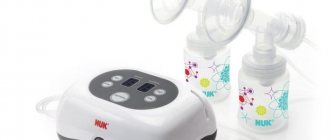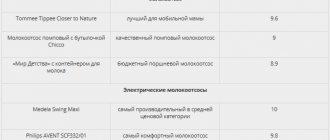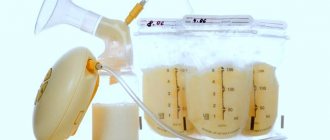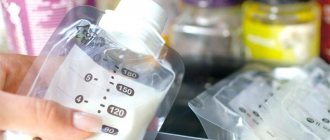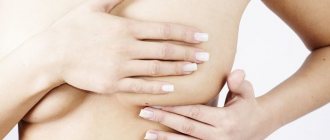Every breastfeeding mother at some point in her “career” feels the need to express milk. Of course, we have it easier than our mothers and grandmothers, who were forced by Soviet punitive pediatrics to squeeze themselves dry after each feeding. Today there is enough information about the proper organization of breastfeeding, which does not require routine pumping. And yet, sometimes knowing how to pump breasts can be of great benefit.
Why express breast milk?
If the birth went without complications, the mother's lactation has improved, and the baby is healthy and sucks well, expressing milk may not be necessary. The female body has a natural mechanism for producing the amount of nutritional fluid for the child that he needs for normal growth and development. However, there are situations in which pumping is the only solution to the problem. It is necessary to express your breasts if:
- stagnation of fluid appears in the mammary gland, leading to blockage of the ducts;
- the child is weakened after a difficult birth, is undergoing treatment, and has not yet developed a sucking reflex (this applies to those in intensive care and premature babies);
- after a break in breastfeeding (breastfeeding) due to illness of the child or mother, the baby refuses or is simply not yet able to latch onto the breast;
- too much time has passed since the last feeding, the breast is so full that the baby simply cannot suck normally;
- the mammary gland has become very full and painful, but it is not yet possible to feed the baby;
- the mother often has to go away on business (work, study), but she wants to maintain breastfeeding and feed the baby her own milk, not formula;
- there is a clear lack of milk, there is a need to stimulate normal lactation;
- the mother plans to continue feeding during the forced break from breastfeeding (business trip, taking medications incompatible with breastfeeding).
Do I need to do this after every feeding?
The secretion of breast milk in the mother's body is a complex mechanism inherent in nature ; the hormones prolactin and oxytocin are responsible for its normal functioning. The baby's sucking of the breast provokes the reflex production of oxytocin by the pituitary gland, which helps the nutrient fluid to be released from the alveoli. Prolactin is responsible for the production of milk itself, the request for the next amount of which occurs after each feeding.
In other words, if breast milk is expressed after feeding, the mother’s body regards this as the child’s “request” for an additional portion of milk , and next time it gives it in reserve. Due to the constant production of secretions in large quantities, hyperlactation starts: there is more and more milk, the mother continues to express herself - the circle closes. For this reason, if you feed your baby on demand, there is no need to express milk after each feeding.
Lactostasis at the end of breastfeeding
If a young mother decides to stop breastfeeding, she also runs the risk of milk stagnation. Since it is released in the same volume, and the child no longer receives it, an excess can easily occur.
Therefore, it is always better to complete feeding smoothly, as it should be, gradually canceling one feeding after another. This way you can avoid the risk of complications.
But sometimes you need to stop breastfeeding one day. The reasons may be different. In such a situation, attention to your well-being should be especially close. If you feel very full and your chest is literally bursting from the inside, you cannot endure it. You definitely need to express a little milk until you reach a comfortable state. At first, it is advisable to somewhat limit fluid intake. Also, do not take hot baths or visit the sauna. All this will help avoid active milk production and lactostasis.
Gradually, lactation will begin to decrease and eventually stop altogether. This process is not very fast, so you should be more attentive to yourself for a certain period of time.
When to Express Breast Milk
There are situations when there is an urgent need to express after each feeding, these are:
- congestion in the mammary gland;
- lack of secretion produced by the glands to feed the baby or insufficient lactation;
- the need to maintain lactation during a forced break from breastfeeding;
- creating a “bank” of milk to feed the child during the mother’s absence.
With stagnation of milk in the breast
If during previous feedings the mammary gland was not completely emptied, one of the milk ducts became clogged , and the corresponding segment of the breast swelled - lactostasis has already formed. In this case, doctors recommend urgently starting to express, so as not to provoke the development of mastitis. This will have to be done every one and a half to two hours and only with your hands. You should massage your breasts carefully, because any touch to the affected area causes pain. During stagnation, you need to express breast milk by hand until the lump decreases and the condition eases, but not longer than 25-30 minutes.
To increase lactation
If you see that the child is nervous under the breast and does not eat enough, it is worth stimulating the production of breast secretions. Here it would be appropriate to express after each feeding and even between meals for the child. Try to empty your ducts as much as possible at least once an hour, expressing for at least 10 minutes each time. Don’t forget about warm drinks, healthy sleep with your baby and frequent night feedings - these are the best helpers in establishing a full-fledged breastfeeding.
When maintaining lactation during a break during breastfeeding
Sometimes a young mother is forced to stop breastfeeding for a while, but she wants to maintain lactation so that after solving the problem, she can continue to feed the baby. In such cases, regular breast emptying will also come to the rescue. The number of pumping sessions to maintain lactation during the break should be equal to the number of times the baby is fed as usual, but not less than once every three hours. It is better to empty your breasts as much as possible so that the growing baby will have enough milk in the future.
For food supplies for the baby while the mother is away
If a young mother studies or works, but it is important for her that her baby eats breast milk, she should express it regularly and leave supplies in the refrigerator during her absence. To do this, you should empty your breasts every time a secretion arrives in it, so that the baby has enough food during your absence. It is very important to maintain lactation at a normal level, so it is imperative to express during your usual feeding schedule and outside the home.
Marmet and other pumping methods
How to pump after childbirth and “get” milk with your own hands? To simplify the pumping process, breastfeeding experts offer several methods, each of which has its own characteristics.
Marmet technology
It is specially designed for nursing mothers. Since this procedure is not completely natural for women's breasts, it is necessary to carefully study all the intricacies of the process and follow the following steps.
- Sit comfortably in a soft chair; it is better to express milk in a sitting position. The back should be straight, there is no need to bend over to avoid stiffness of the muscles.
- The container must be sterilized before the procedure (if the milk will then be used) and placed at chest level, holding it with your left hand.
- The thumb of the other hand is placed on the upper part of the peripapillary area - where the border of the areola and white skin is located (the nipple is located below). The index finger is placed opposite the thumb, and together they form the letter “C”. The rest should support the mammary gland.
- The fingers gently press on the chest, then they are brought together in a ring, squeezing the areola area. As soon as the milk appears, the fingers relax, then the action is repeated.
- To express all areas of the mammary gland, the fingers must be moved sequentially around the circumference of the isola. Such actions are especially relevant when milk stagnation occurs.
In addition to the Marmet technique, there are other techniques that help to obtain milk from their mother's breast. They are usually used if the previous method did not bring results.
Warm bottle method
This method is used if the nipple is tense and the mammary glands are inflamed. In such situations, it is extremely difficult to get milk, and it is impossible to latch on to the baby.
To express milk with your hands or to relax the breast to such an extent that the baby can take the nipple into his mouth, a bottle is used. This container with a neck width of at least 4 centimeters must be heated with boiling water and the upper part cooled.
Then the area around the nipple should be lubricated with Vaseline and a container should be placed on it. The papilla will begin to retract into the bottle, and the milk will begin to flow out. As soon as the streams become weak, the bottle is removed.
Nipple compression method
If the nipples begin to become rough, and pain is felt when pressing them, a special method will be required, which involves the primary release of milk.
To implement this method, you need to place all your fingers directly on the nipple and press on it for three to four minutes. Such actions soften the mammary gland and make the pumping process less painful.
How to properly express breast milk by hand
The easiest and most accessible way to empty your breasts is to express them with your hands. This must be done in the following sequence:
- Take a clean, sterile, wide-necked container (not a bottle) and place it directly under your breasts.
- Place your palm on the breast so that the thumb grabs the areola just above the nipple from above, and the other four fingers seem to support the breast from below.
- Using your thumb and forefinger, gently press the areola in the direction of the nipple, but do not squeeze the nipple itself. Squeeze out the milk, using your lower fingers to press the mammary gland to the chest.
- After several pressures, move to the next milk lobe, moving in a circle and carefully emptying all the ducts in order.
Pros and cons of hand expression
Emptying the breast by hand is a procedure that has both its positive aspects and some disadvantages. The advantages of manually expressing breast milk include:
- Affordability – the manual method does not require any costs.
- Additional stimulation of lactation due to the gentle impact of fingers on each milk lobe.
- Safety - if you express correctly, mechanical injuries to the nipples and breast tissue will be excluded.
The few disadvantages of hand expression are that:
- This procedure requires a sufficient amount of time.
- It is difficult for inexperienced mothers to understand how to properly express by hand.
Technique and features of the procedure
The quantity of milk largely depends on how the mother relieves the breasts of milk.
The correct technique allows you to avoid pain and discomfort.
If you put strong pressure on the soft tissues of the chest, you can damage the milk ducts, which can lead to blockage and inflammation.
After this, you won’t be able to avoid going to the doctor, so it’s better to learn how to properly drain milk in advance.
With soft massaging movements of the fingers, stroking movements are made towards the alveoli. You can grab the breast at the very base and gradually work your way down to the nipple. Under no circumstances should you click on it .
It contains the milk ducts, which have a very thin diameter. Any careless movement can damage them, which will lead to the inability to feed the baby.
This algorithm of action is very effective, it stimulates lactation and will help increase the amount of milk if you perform the procedure regularly.
Expressing breast milk with a breast pump
It is much easier and faster to empty the mammary gland using a special device - a breast pump. Even the principled Doctor Komarovsky recommends that if you need to pump, you should immediately turn to this technical device. How to properly express breast milk with a breast pump:
- It is convenient to sit in a chair so that the nipple is pointing down.
- Think about your baby and imagine that it is he who is sucking the breast, and not the device that imitates the sucking reflex.
- Direct the nipple into the center of the funnel and, starting with the lowest level of traction, gently express milk for 15 minutes from each gland.
- After expressing, thoroughly wash all parts of the breast pump with hot soapy water.
How to choose the right breast pump
The choice of a breast pump should be taken very seriously, because the health of the breastfeeding mother’s mammary glands and the amount of expressed milk will depend on the quality of the device. The modern market for such devices is filled with many models with different technical characteristics and prices. The first criterion based on which you should choose a breast pump should be the purpose and frequency of use:
- If you need a device for expressing in rare cases, you can purchase the simplest, inexpensive device in the form of a plastic tube with a bulb.
- If there is a need for constant, regular pumping and maintaining lactation at a high level, it is better to immediately choose a good electric model.
Advantages and disadvantages
Expressing breast milk using a special device has a number of advantages over the manual method:
- Modern models of breast pumps are able to express both mammary glands in a matter of minutes.
- It is convenient to express using the device; you can even empty one breast while feeding the other.
- Expressing with a breast pump allows you to get the maximum possible portion of nutrition for your baby at one time.
However, along with the advantages, this method also has several significant disadvantages:
- An incorrectly selected, poor-quality or poorly mastered device by a young mother can seriously injure the gland.
- The process of expressing with a breast pump itself is aesthetically unacceptable and very unpleasant for some women.
Possible errors
Emptying your breasts will be effective and painless if you follow all the steps correctly. Any action should be gentle and soft. The efforts made will have a bad effect on the condition of the breast. Stimulate, squeeze or massage the juices to no avail. The milk is in the ducts, so only the area near the nipple is compressed.
The entire process is performed in a relaxed state. When bending forward, discomfort in the lumbar region is possible, but milk will not increase. Do not injure the breasts or press with force on the areola area, leaving dark marks and bruises. A woman should focus on the volume of pumping - not to overstrain the gland to the point of pain.
How much milk should you express at one time?
Not a single mammologist or breastfeeding expert can say exactly how much milk you can express at a time, because several factors influence the amount of secretion produced in the mammary glands:
- Pumping time. If you try to express your breasts immediately after feeding, there may be absolutely nothing there (unless the woman has developed hyperlactation). If you express before feeding, the approximate volume of milk will vary between 100-150 ml.
- Compliance with the correct technology for manual expression. With the wrong approach or inability to express, an inexperienced mother may not squeeze a single drop out of the gland. If you do everything according to the instructions, you will be able to express from 50 to 80 ml of milk.
- Breast pump quality. An incorrectly selected or low-quality device can injure the gland and be ineffective. A good breast pump will be able to extract almost all the accumulated milk from the breast, which is approximately 120-175 ml.
- Mother's emotional state. If a woman for some reason experiences anxiety, is tense and cannot relax, the brain temporarily blocks the production of hormones responsible for the secretion of milk. In this state it will be very difficult to express.
- Proper preparation for pumping: warm drinks, warming the breasts, massage. If you do not wait for the tide to flow, the portion of expressed milk will be scanty. When the milk arrives, it can be expressed to the maximum.
Optional Terms
Before starting the procedure, the woman determines the importance of pumping. Experts say that if the baby was born full-term, healthy, and the woman is not taking medications, breast stimulation is not necessary. The newborn will restore lactogenesis to the required level on its own.
If there is an excess of milk, frequent emptying of the breast will increase the amount of milk. The lack of milk must be restored through proper latching of the baby on demand. Post-feeding is not necessary.
Rules for expressing breast milk
There are a few simple rules for expressing breast milk:
- To stimulate the flow of secretions and express quickly and painlessly, before starting the procedure you should drink a cup of hot tea, take a warm shower or warm your chest with a well-heated diaper.
- It is imperative to follow the rules of hygiene: before pumping, wash your hands and mammary glands with warm water and soap, dry well with a clean, soft towel.
- To express milk comfortably, you should initially take a comfortable position in a chair or on a bed.
- You can only express milk into a clean, boiled container, so it is better to prepare it in advance.
- It is necessary to begin expressing as soon as the milk begins to arrive, continuing the procedure until the mammary gland remains completely empty.
- The main thing is that during the procedure the woman should not experience any discomfort in the mammary gland. If pain occurs during the process of expressing breast milk, it must be stopped immediately until the cause of the discomfort is determined.
How to pump your breasts for the first time
Immediately after childbirth, colostrum begins to be released from the mother’s breast in small quantities, which only after a few days turns into full-fledged milk. In order to properly start the lactation process and ultimately feed your baby for a long time, it is very important to successfully pump the first time. To do this correctly, you need to know the basic rules of the first straining:
- The first pumping of breast secretions is possible only a day after delivery.
- In the first days, do not pump more than two or three times a day.
- You can then partially empty your breasts several times a day between feedings.
- Squeeze out the milk until you feel relief, not until the last drop.
- Do not pump after 10 p.m., because more prolactin is produced at night, which stimulates the secretion of breast milk and can trigger the process of hyperlactation.
Features of the procedure for stagnation or mastitis
Often nursing mothers suffer from such an unpleasant problem during breastfeeding as lactostasis, which can quickly develop into mastitis. Lactostasis is a blockage of the milk duct and stagnation of milk, and mastitis is an inflammatory process in the breast tissue. To properly drain your breasts during stagnation, you must:
- Stimulate the production of oxytocin and properly prepare for pumping: take a warm drink or shower, calm down.
- Carry out a warming massage, lightly rubbing the glands in a circular motion with your hands.
- Express milk by hand or with a breast pump until your breasts are relieved and soft.
- Keep your breasts open for 10-15 minutes after pumping to allow a new portion of secretion to enter the ducts.
Preparing the mammary glands
Two main hormones are responsible for the process of formation and secretion of milk secretion. It is on their “work” that the course of lactogenesis depends; a woman’s diet or drinking plenty of water is practically not involved in lactation.
- Oxytocin. This hormonal substance provokes an influx of milk when exposed to certain “stimulants”. For example, oxytocin is activated when a newborn is applied to the breast, when the smell of the baby is felt, or when the glands are stimulated. If oxytocin is released, the milk flows out on its own without requiring any effort.
- Prolactin. This hormonal substance is intended to control the volume of milk secretion. It “counts” the amount of milk removed from the breast and returns the same volume. Due to this, the breasts are practically not emptied during lactation.
Breast pumping will be effective if these hormones begin to work. To “turn them on” and cause a flow of milk to the glands, it is necessary to carry out preliminary preparation.
It may include the following activities:
- applying towels to the chest, previously soaked in warm water, or standing under the stream of a non-hot shower;
- drinking warm, weak tea or any other liquid (it is important that the drink is heated);
- light and gentle massaging of the mammary glands;
- stimulating milk flow, for example, by bending down.
When performing these activities, the mother should think about her beloved newborn baby. The ideal option is to sit next to the baby to feel him better.
The flow of milk secretion will be more effective if you offer one breast to the baby and strain the other. This technique is good because when the baby sucks, milk will flow into both breasts at once.
Is it possible to store expressed milk?
Mother's milk is not only the most delicious, but also the healthiest food for a baby, because with it the child receives immunity for life. To ensure that your expressed milk brings maximum benefit to your baby, store it correctly. Here are some important points about storing breast milk:
- Milk can only be stored in sterilized, hermetically sealed glass containers.
- Freshly expressed milk can be stored at room temperature for eight to 12 hours.
- In the refrigerator, breast secretion remains suitable for feeding the baby for 7-10 days, but it is better to keep jars of milk in the back of the shelves.
- Regular freezers keep breast milk fresh for up to three months, while deep freezers keep breast milk fresh for up to six months.
Necessity of the procedure
Manual expression
There are several situations in which it becomes necessary to express breast milk:
- After childbirth, lactation begins. A woman usually produces milk in large volumes on the second or third day. If a newborn baby is not able to cope with such a large flow of milk on his own, he needs help with this. The breast should be pumped a little before feeding until it softens. It is important not to overdo it, otherwise even more milk will arrive at the next feeding .
- If the child does not have a developed sucking reflex or has one, but it is weak. Since the baby needs nutrients, it is necessary to express the breast and feed the baby with a bottle.
- If there is a lack of milk, it is better to express after feeding. The result of insufficient milk supply is most often feeding by the hour, which subsequently leads to the complete disappearance of milk. The best thing to do is not to torture yourself and the baby and feed on demand. Even if, after nine months, mother and child separate, the woman’s body still works during lactation, as the baby needs it. And feeding by the hour will exhaust the mother, and the baby will be capricious and cry constantly.
- Lactostasis (painful tightness in the breast due to stagnation of milk). Lactostasis is common among nursing mothers. Stagnation occurs for various reasons. This may be due to lack of sleep, certain physical work in which the muscles of the arms and shoulders tense, or too long a period between feedings (new milk accumulates and builds up in the breast, since the old one has not yet been released). Stagnation in this case can lead to mastitis. In such a situation, pumping cannot be avoided.
- The child bites through the breast and breastfeeding becomes a whole ordeal for the mother. This happens when babies are teething and are trying to relieve the itching. The second reason is that the nose cannot breathe. The child feels discomfort and, thus, signals his mother about his problem. The third reason and the most common is improper attachment to the breast.
- If she takes medications that are contraindicated during breastfeeding, she will have to stop breastfeeding for a while. The milk will need to be expressed and thrown away, as it is dangerous for the baby.
Chest pain
The benefits of hand expression
If you have a choice between manual and mechanical pumping, then manual pumping is undoubtedly the best option. The only downside to hand pumping is that your hand swells during the process. But this can only indicate an incorrect pressure technique.
Unlike manual expression, a breast pump has a number of disadvantages:
- the entire breast is felt by hand and milk is expressed from all canals, which cannot be done with a breast pump;
- there is no need to spend money on the device;
- due to constant squeezing of the breast pump, the hand quickly gets tired;
- A breast pump can also cause cracked nipples.
How to feed your baby
After exposure to low temperatures, mother's milk loses some of its nutrients, but still remains the best food option for a baby. If you need to feed your baby expressed milk, it is important to know:
- Breast milk contains a large amount of fats, which over time can break off and sit on top of the nutritional fluid. Shake the bottle well before feeding to ensure uniformity of the product.
- Even if the recommended “expiration date” of the milk has not yet passed, smell and taste the baby’s food before feeding it. It should not be bitter, sour, or have foreign odors.
- To preserve maximum nutrients and a homogeneous liquid structure, defrosted milk should first be kept in the refrigerator for a while and then heated.
- Milk for feeding and the baby’s body must have the same temperature - 36 degrees, so the product must be heated before feeding the baby. Under no circumstances should you use a microwave, as it heats the milk unevenly, which inevitably leads to the destruction of a large amount of nutrients. It is better to bring your baby's breastfeeding to the desired temperature using a cup of hot water, a water bath, or a special electric heater.
Why do this? Mandatory or not?
Every mother whose baby is breastfed often has to receive milk without the help of a baby.
This may happen for the following reasons:
- Abundant milk flow, which is beyond the baby’s strength;
- If the mother leaves for several hours, but does not want to tear the baby away from breast milk;
- The lack of milk forces women to use different methods to produce it more intensively;
- Taking medications or products that are not compatible with breastfeeding.
Often the mother cannot be with the baby all the time. This may be due to going to work or being away on business or to the store.
In this case, it is better to leave the expressed milk so as not to resort to using adapted formulas.
Mother's milk is the most suitable food for a baby; it contains all the vital vitamins and microelements.
The most useful articles for young mothers: the rate of weight gain in newborns, what a child should be able to do at 1 and 4 months. Why does he hiccup after feeding, why is the white coating on the tongue dangerous and how to teach your baby to sleep separately.
What is better: manual pumping or hardware pumping?
For many mothers, the key factor is that high-quality and functional equipment is expensive. In addition, properly organized manual expression helps maintain and increase lactation, and is generally physiological.
It is also important that you can express by hand at any time in any secluded place, without preparing devices and attachments for this. If you follow the correct technique, manual pumping will not damage your breasts.
Of course, it was not without its drawbacks. The process is quite lengthy, on average 25-30 minutes, and not every mother, especially one with many children, has the opportunity to devote that amount of time.
The first rule of manual straining is to thoroughly follow the technique, and not everyone can do this right away. Sometimes it takes weeks of training.
How to get your milk flowing
In order for your efforts to have results, the process of milk formation and milk release will have to be started without the participation of its natural catalyst - the baby. There are certain techniques that ensure the so-called flow of milk. Each woman has her own tricks in this regard, but until you decide on the best method specifically for you, you can use the most common techniques:
- Take a warm shower or simply apply a towel soaked in warm water to your breasts.
- Drink your favorite drink (such as tea). It doesn’t matter what you drink, the main thing is that it does not violate the principles of nutrition during breastfeeding, and that the liquid is warm.
- Give a light and pleasant massage to your chest, as if kneading it. Movements should be smooth, soft and not cause discomfort.
- Bend down and stand for a while so that the milk flows due to the force of gravity.
When following any recommendation, it is important to think about your baby, remember his touch, smell. Ideally, express in close proximity to the baby. For example, if a baby is suckling on one breast, the flow of milk into the second is guaranteed, you can express it simultaneously with feeding, and almost completely.
If it is not possible to be in close proximity to the baby, the baby’s things will come to your aid. The baby's smell starts the process of milk production better than any tricks or tricks. Just smell the baby’s underwear, ideally the hat that the baby has been wearing for a couple of hours. This will be enough to make the streams of secretion from your mammary gland stand out more cheerfully under the influence of your fingers.

